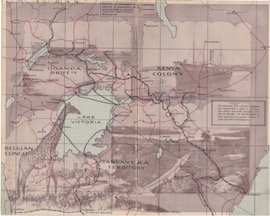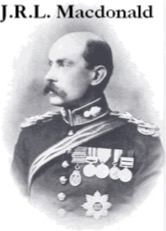The First Kenya Railway Survey

The final routes of the East African Railway
Now that the new railway is again under consideration it is interesting to look at the original plans for the first Kenya-Uganda railway. The preliminary surveys were made in 1891 and 1892 and it was on these that the first building of the railway was based. Construction of the regional line to the lake was started in 1896 and completed in 1903.
The preliminary survey party arrived in Mombasa on 24 November 1891: ‘It was a beautiful morning when we entered the harbour and from the bridge of the Modasa the view was exceedingly pretty. An old Portuguese fort, half in ruins and overgrown with moss and creepers, guards the entrance on the island side. Across the water on the mainland the Mission Settlement of Frere Town is just visible through a fringe of palms. Evidences of European occupation are visible in the trim little bungalows and the landing place at English Point opposite the fort.’ The survey party was met by officials of the Imperial British East Africa Company and camp was pitched at Kilindini. The next three weeks were busy while medical and ammunition loads and provisions were collected. Altogether 411 Africans, 41 Indians and seven Europeans were employed to survey a route for the railway. The porters received 10 rupees a month and rations and carried a load of 50 pounds; their flour ration was 1½ pounds per porter per day.
The survey was led by James Ronald Leslie Macdonald, with John Wallace Pringle as second-in-command. Also assisting were Philip Geoffrey Twining, Herbert Henry Austin and Sergeant F.H. Thomas. The survey party divided into two, one to cross the Taru desert to Tsavo, and the other to go northwards to the Sabaki River, and then travel inland along it. The two divisions were to meet at Tsavo. On 18 December Pringle marched out of Mombasa and reached Tsavo on 11 January 1892.

At Tsavo the reunited party again divided into two, one division returning to the Sabaki to follow it until opposite Nzoi peak, where it would rejoin the other party travelling direct to Nzoi. Thereafter the whole group proceeded to Machako’s village where the Imperial British East Africa Company had a fort. Here more rations, including 36,000 pounds of flour, were purchased with some difficulty and transported to Kikuyu, where there was a Company settlement at Fort Smith, in present-day Kabete.
The plan was ‘one party should survey a line up to Lake Nakuru, ascend the Mau escarpment, cross the Guaso Ngishu plateau to the Nzoia River, and follow this river to Mumia’s. A second party was to examine a line through Sotik and Lumbwa to Ugowe Bay [now Winam Gulf] on the great lake [Victoria], thence on through South Kavirondo to Mumia’s, where they were to meet the first party.’ The survey party set off from Fort Smith and walked to the edge of the Kikuyu escarpment, described by them as one of the finest views in Africa. They descended to camp by the Kedong River in a grove of acacias. As they proceeded to Lake Naivasha they came across Maasai in a shockingly emaciated state, which they ascribed to the rinderpest epidemic decimating their cattle for several years running. Now the party split in two again, Macdonald taking the northern group, and Pringle the southern.
After Eldama Ravine Macdonald’s party struggled for two days through dense forest into the grasslands where the Mau escarpment splits into the Kamasia and Elgeyo ranges. They reached Mumia’s village where ‘both sexes go entirely naked’. Mumia, the chief, was ‘an amiable youth, very friendly to Europeans’. Pringle’s Sotik party joined them at Mumia’s, having climbed over 10,000 feet through thick bush, open glades and juniper trees contorted into amazing shapes by overcrowding. They met Wanderobo, whom they described as intermediaries between the Kikuyu and Maasai. They had been to Ugowe Bay (Winam) where they launched the boat they had carried with them in sections from the coast, and surveyed the lake’s edges.
After the rendezvous at Mumia’s one party went to survey the lake, another proceeded to Mt Elgon, and a third went to Kampala. A complete survey was done around the shores of the lake. Then it was time to amalgamate for the return to the coast. Mombasa was reached on 23 September 1892. From November 1891 the party had marched 4,280 miles and surveyed 2,374 miles. Its report favoured a railway of 657 miles. Most of the route outlined in the survey was eventually followed when the railway was built.
http://www.europeansineastafrica.co.uk

Recent Comments